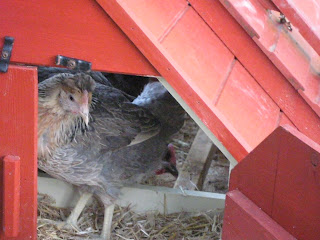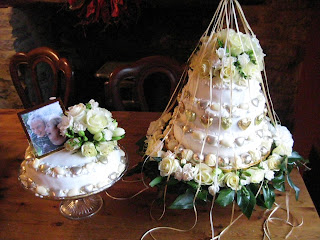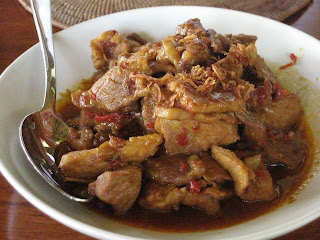
As you would imagine, chillies play a large role in Balinese cooking. There are three types available on the island,
cabe, a large green
chilli which is quite hot, the
Lombok red chilli (which is the mildest) and the local small fiery chillies -
tabia krinyi - similar to birds eye chillies, but hotter! We were told to approach them with caution.

On a visit to a temple, bowls full of the
tabia krinyi were being prepared - I can't begin to imagine how hot the food would have been! You can tell how hot a
chilli is by looking at it - the thinner the skin and the more seeds, the hotter it is. We were also told that the best way to test how hot the
chilli is is to rub the sliced
chilli on your wrist and see how long it takes to heat up (not something I would recommend).
All this is by way of introduction to the Balinese base spice mix -
Bumbu - which is used in most local dishes and uses two types of
chilli.
Balinese
Bumbu4 large red chillies,
deseeded and sliced
4 cloves of garlic, peeled
12 small red shallots, peeled
2 red bird eye chillies,
deseeded4 almonds or 2 Brazil nuts (or 2
candlenuts if you can find them)
a good grate of nutmeg
2 inch piece of ginger, peeled
2 inch piece of
galangal, peeled
2 inch piece of fresh turmeric (or 2 tsp powdered turmeric)
2 tsp tamarind puree
2 tsp palm sugar (you can substitute
muscovado but palm sugar is seriously yummy and I think slightly addictive! I bought 4 kilos home with me!)
1 tsp roasted shrimp paste
3 tbsp vegetable or coconut oil
2 sticks lemon grass (crushed slightly with the handle of a knife to release the flavours)
300ml water
I should add that this recipe originally contained
Kencur root (part of the ginger family and similar to
galangal) but I have been told that this is not available outside Bali as it does not transport well and also Salem leaf which is added with the lemon grass at the end of the recipe. We debated on our course whether you could substitute a bay leaf but all agreed that this would not be right. We also thought (probably much to the horror of any locals) that the
salem leaf did not have much scent so would not really be missed if omitted.
Add all the ingredients (save for the oil, lemon grass and water) to a large pestle and mortar and pound to a fine paste. The Balinese do this using an
ulekan - a large lump of lava rock carved into a bowl with a second smaller stone that you hold in your hand and rock backwards and forwards. There is an art to using it properly which takes practice - practice that I will sadly never get as my luggage allowance didn't allow for large lumps of lava rock!
When you have a fine paste, add the oil to a small saucepan and heat the paste gently for a few minutes. Add the lemon grass and the water and simmer the
Bumbu until the water has evaporated and you have a thick paste again. This will take approximately 10 minutes. Remove the lemon grass stick.
This quantity will make enough for one or two dishes. You may wish to double up the recipe and make extra for freezing. You can keep it in the fridge for up to two weeks under oil (vegetable not olive oil) as you would pesto or freeze it in ice cube trays (where it will keep for a good two months).
This paste is really
versatile and can be used as the base for any curry dish. If you want it hotter, leave the
chilli seeds in! The hotel swirled this spice paste through their bread rolls before baking them to give a delicious curry
chilli bread - something I will definitely be making. This paste will be used in the recipes I will be posting this week.
 Happy Halloween everyone! I have been busy baking this morning for our Halloween party this evening! Joshua, Rosie, Lili and Zara are all coming for tea and some Halloween treats! This is a lime coconut and vanilla cake with cream cheese frosting and a positively luminous orange fondant icing.
Happy Halloween everyone! I have been busy baking this morning for our Halloween party this evening! Joshua, Rosie, Lili and Zara are all coming for tea and some Halloween treats! This is a lime coconut and vanilla cake with cream cheese frosting and a positively luminous orange fondant icing.  The marshmallow teacakes are simply decorated with some chocolate fudge icing and some Halloween sweets! Just two pumpkins to carve, some chocolate cupcakes and cinnamon bats still to do - it's going to be a busy day!
The marshmallow teacakes are simply decorated with some chocolate fudge icing and some Halloween sweets! Just two pumpkins to carve, some chocolate cupcakes and cinnamon bats still to do - it's going to be a busy day! Cinnamon Bats
Cinnamon Bats











































